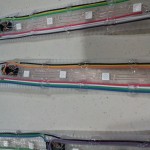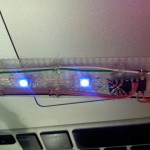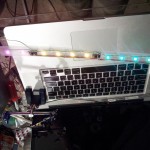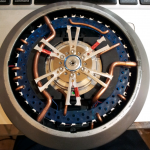It lives!
Jellyfish Interface
Props, Costuming, and Special FX
Monthly Archives: April 2012
Jellyfish rewiring
Check out all those beautiful, straight, smooth swaths of wire! Gorgeous, right? It took dozens of tedious hours to make.
One problem. Data apparently goes through them at 2MHz, which means they’re basically turned into radio antennae – and since they’re all nice and parallel, there’s more “interference” than there is “signal”.
The poor umbrella flashes and flickers in a manner best described as “grand mal”, no matter what it’s supposed to do. It’s time to rip out all that beautiful cabling and replace it with twisted-pair wire (and add terminating resistors). Sigh.
First jellyfish panel
No more prototypes; this is the real thing. Each jellyfish will have eight of these strips, with each segment individually controlled. Yep, the soldering’s pretty ugly, but it works!
Second reactor complete
The second reactor’s internals are done, and I’ve added the spinny-bits to the motor’s drive hub. Now all that’s left is a paint job! We may end up re-working the insides of the first reactor, as we came up with some cleaner wiring and three-dimensional tricks for the transistor clusters. The battery door actually closes on this reactor, and I really want that to work on the first reactor, too…
First Jellyfish segment
Just finished assembling the first segment prototype for the jellyfish! The good news: we can apparently run the WS2801 chips with 12v LED series, so we don’t have to buy (and solder) 150 transistors like we feared. Each umbrella will have 24 of these segments for a whopping 211,000mcd of light.






